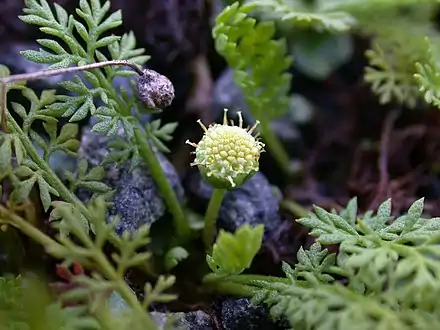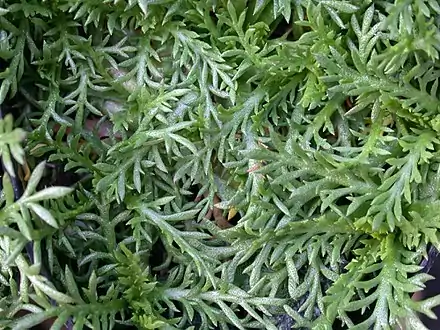| Cotula alpina | |
|---|---|
 | |
| Scientific classification | |
| Kingdom: | Plantae |
| Clade: | Tracheophytes |
| Clade: | Angiosperms |
| Clade: | Eudicots |
| Clade: | Asterids |
| Order: | Asterales |
| Family: | Asteraceae |
| Genus: | Cotula |
| Species: | C. alpina |
| Binomial name | |
| Cotula alpina | |
Cotula alpina, also known as the alpine cotula, is a perennial herb in the family Asteraceae. It is a small flowering plant that forms ground covering mats and is well adapted to alpine environments.

Description
Alpine cotula has flat glabrous light-green leaves that are pinnately divided almost to the midrib.[1][2] It forms a large number of rosettes which lie just above ground level while the leaves are hairless and between 1–3 cm in length and 5–10 mm wide.[1][2] They are slow growing plants and are often stoloniferous.[3] It can be easily confused with Leptinella filicula which has similar looking leaves and is also part of the family Asteraceae.[4] Flowering occurs from spring through to summer.[2] Each rosette produces a single yellow to cream flower, about 7 mm in diameter.[3] They are at the top of erect stalks that are generally shorter than the leaves but extend further when fruiting.[5] A unique characteristic of C. alpina is that the flower-bearing stalks are hollow.[3]

Distribution and habitat
Cotula alpina is found in heath, short herbfield and tussock grasslands in alpine and sub-alpine areas.[1] It is common in the Central Plateau and Midlands of Tasmania and can also be found at high altitudes in Victoria and New South Wales.[2] The herb can survive in shade to full sun and requires high moisture levels for growth.[3] It can also tolerate clay, loam and sandy soil types and is phosphorus intolerant.[3] It can survive through exposed environmental conditions including high winds and low temperatures including snow and frosts.[5] It has been reported to show grazing resistance.[6]
Seed and germination
Cotula aplina has achenes, which are hard, dry fruit which contain a single seed. As the seed matures, the achenes loosen towards the top and develops a fluffy appearance.[5] The seeds are 1.5–2 mm long, compressed laterally and germination can occur after 2 to 4 weeks.[5]
References
- 1 2 3 Kirkpatrick, J. (1997) Alpine Tasmania: An Illustrated Guide to the Flora and Vegetation. South Melbourne, VIC: Oxford University Press. Pg 71
- 1 2 3 4 Whiting, J., Roberts, J., Reeves, R., Tayler, F. & Tayler, V. (2004) Tasmania's Natural Flora. Ulverstone, TAS: Tasmania's Natural Flora Editorial Committee. Pg 37
- 1 2 3 4 5 "Cotula alpina" PlantNET- New South Wales Flora Online. Royal Botanic Gardens & Domain Trust, Sydney Australia. Retrieved 5 March 2018
- ↑ "Leptinella filicula" PlantNET- New South Wales Flora Online. Royal Botanic Gardens & Domain Trust, Sydney Australia. Retrieved 8 March 2018
- 1 2 3 4 "Cotula alpina" Understory Network. Understory Network Incorporated, Glenorchy Tasmania, Australia. Retrieved 5 March 2018
- ↑ Bridle, K. L. & Kirkpatrick, J. B. (1998) "Why do tall herbs rarely dominate Tasmanian alpine vegetation? Evidence from islands in the Ouse River system". Papers and Proceedings of the Royal Society of Tasmania. 132 pg. 9-14